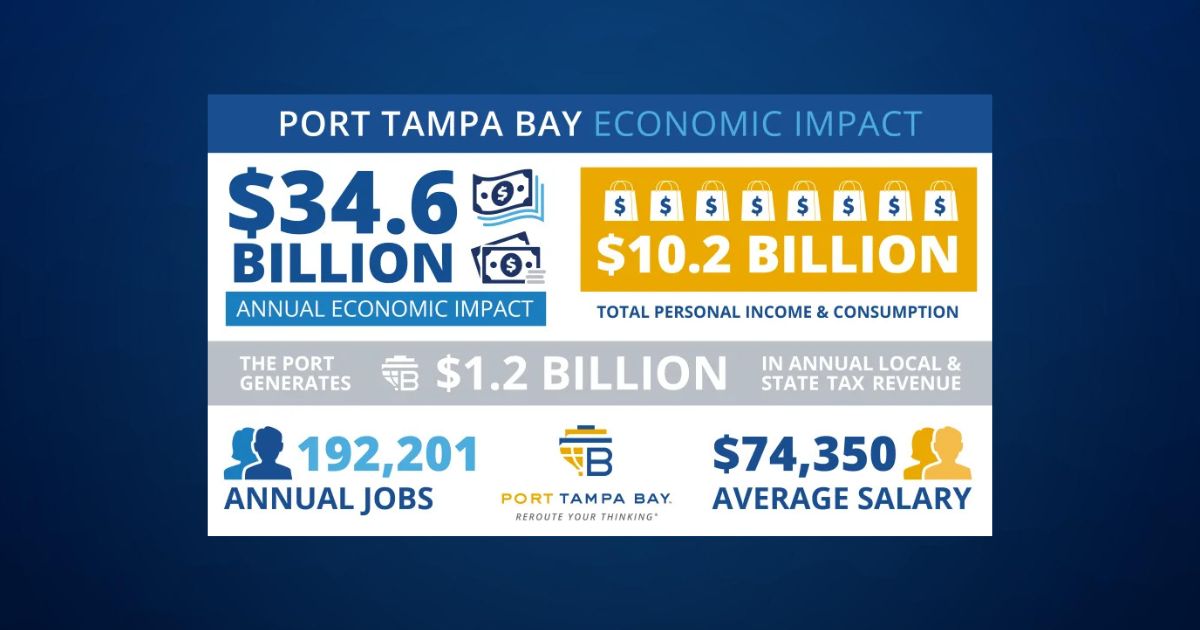Port Tampa Bay released figures on its economic impact. Below is an official statement from the port.
Florida’s largest and most cargo-diverse seaport, has a 34.6 billion dollar economic value on our region and supports more than 192,000 total jobs. A newly released economic impact report, published by Martin and Associates who are industry leaders in maritime research, showed the port more than doubled the jobs supported by port activity and nearly doubled the total economic value supported by the port in the region.
“Port Tampa Bay is proud of its role as West Central Florida’s largest economic driver. Our port has continued to make strategic investments for our future, including deepening our shipping channels, improving resiliency throughout our port facilities, and growing and expanding our containerized cargo business. The jobs and money poured back into our regional economy is a direct result of our strategic growth,” explained Port Tampa Bay President & CEO Paul Anderson.
The port’s total economic value to Florida is $34.6 billion. This includes the $4.6 billion of direct business revenue, the re-spending and local consumption impact of $2.8 billion, and the related user output of $27.2 billion. This dollar value represents the sphere of influence of the marine terminals, shipyards, and non-maritime real estate holdings in 2023.
“Florida’s Seaports play an important part in keeping up with our state’s growing economy and population as more and more families flock to our great state. As Florida’s largest port, Port Tampa Bay has prioritized key investments and public and private partners to continue its growth, keep our supply chain going and provide great jobs for local families. I’m proud to congratulate Port Tampa Bay on its continued success and massive economic impact on our state,” said U.S. Sen. Rick Scott, Florida.
The study, which measured impacts through calendar year 2023, also found that Port Tampa Bay contributed $10.2 billion in personal income, with an average maritime-related salary of $74,350, which far exceeds the state’s average salary for all occupations of $55,980. As a result of re-spending this income, an additional $2.8 billion of income and consumption expenditures was created.
“Port Tampa Bay is a vital cornerstone of economic strength and opportunity for neighbors across the region,” said U.S. Rep. Kathy Castor, Florida. “With over 192,000 jobs and a $34.6 billion economic impact on our region, this remarkable growth highlights the critical role the port plays in driving innovation, creating good-paying jobs and strengthening our local communities. I am proud to see these strategic investments in infrastructure and resiliency paying off for families and businesses across the region. Together, we will build toward a brighter, more prosperous future for Tampa Bay.”
In 2023, the 35 million tons of cargo and more than 1.1 million cruise passengers, as well as shipyard building and repair and non-maritime real estate operations supported 192,201 direct, indirect, induced, and related jobs in Florida. Of those, 16,119 direct jobs were generated by Port Tampa Bay’s marine cargo, cruise, shipyard, real estate, and operations.
“Port Tampa Bay is crucial to the Tampa Area and continues to lead as one of the top ports in the region, supporting more than 192,000 jobs. This latest report validates Port Tampa Bay’s role as West Central Florida’s largest economic driver, helping fuel demand in our communities and through the I-4 Corridor to Central Florida and beyond. We are fortunate as a community to have this job-creator and economic driver in our backyard. I am eager to see the continued growth and impact the Port makes for our community,” explained U.S. Rep. Laurel Lee, Florida.
State and local taxes supported by all activity at Port Tampa Bay totaled $1.2 billion, which includes $497.5 million of direct, induced, and indirect state and local taxes, as well as nearly $727.4 million state and local taxes that were supported by the economic activity of related users (importers and exporters) of the cargo moving through the Port.
The port’s last economic impact study was conducted in 2015. Since that time, the port has seen a near doubling in several indicator areas.
The impact study prepared by Martin and Associates was measured for calendar year 2023 and is estimated in terms of jobs, personal earnings, business revenue, and state and local taxes.













